Updated March 14th, 2023: Since the original publication of this article, Google has introduced a wide range of core updates, ranking systems, and the addition of Experience to E-A-T. These new systems and Quality Rater Guidelines don’t necessitate a significant departure from best practices in content strategy but encourage additional considerations for developing trust factors in the eyes of your audience, readers, and search engines.
Core updates? Can’t beat them so might as well join them. In August 2018, Google rolled out a large and widespread update that made sites roll. Many SEOs noted that the core algorithm update was one of the largest they had seen and while the impact on sites was widespread, the dominance was in the health and YMYL (Your Money, Your Life) categories, dubbing the update “Medic.”
Well, Google was not finished. Subsequent updates came in September 2018 and in March 2019, with a core update that appears to be a continuation of the earlier Medic update. This time the update, lighter than the 8/1 update, has restored or reversed the loss of traffic many of the sites saw in August.
Dr. Pete from Moz wrote about the update using Moz’s Temperature Tool and was able to surmise the top verticals/industries affected by the August update. Looking at the top 30 winners and losers, it appears that Health and YMYL sites were the hardest hit in August.
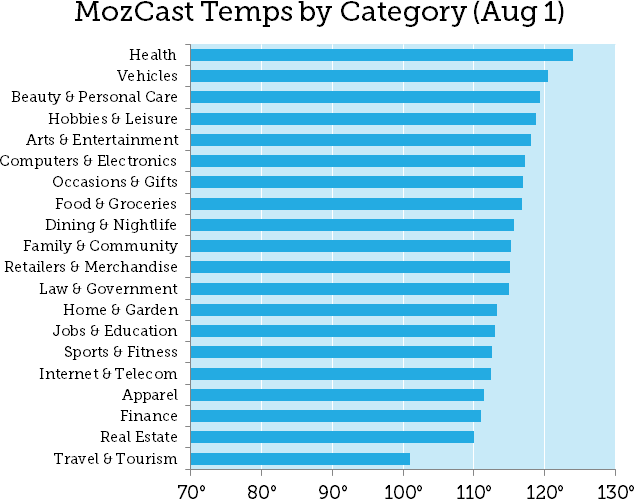
With the March 2019 update, many sites have recouped the loss from 8/1 and Glenn Gabe of GSQI, reviewed a number of sites from the August update to the March. While many are bouncing back, the recoveries are varied with some nowhere near where they were before August.
SINCE 8/1, WHAT DOES GOOGLE WANT?
Based on analysis, the August core algorithm update was deemed a move on Google’s part to improve its quality metrics, particularly the E-E-A-T factors that influence organic rankings. Experience, Expertise, Authority, and Trust factor into the SERPs and it is in Google’s best interest to provide expert, authoritative and trustworthy content to users, especially in public-facing spaces such as health and YMYL.
The March update appeared to be a rollback or leveling off of the August update, however Google is still moving in the direction of providing hyper-relevant, trustworthy content for its users. Websites and brands need to be thinking this way too.
While Google has stated that there was no “fix” for a broad algorithm update like the one on 8/1, Danny Sullivan, Google’s Search Liaison, did say on Twitter:
Want to do better with a broad change? Have great content. Yeah, the same boring answer. But if you want a better idea of what we consider great content, read our raters guidelines. That's like almost 200 pages of things to consider: https://t.co/pO3AHxFVrV
— Danny Sullivan (@dannysullivan) August 1, 2018
While this comment did not entirely reveal what sites—those severely impacted and others—can do to recoup their losses, it did tell us, content strategists, SEOs, and developers, how to move forward in regard to broad algorithm shifts. Additionally, it sent the flare up on great content.
UPDATE: December 2022 – Google Adds an E to E-A-T
Over the past few years, Google has continued to refine the core updates and has even started to transparently let SEOs and content strategists know when new system rankings and core updates are rolled out.

With approximately three core updates per year, websites that use manipulative tricks and tactics that attempt to game the algorithms can ultimately find themselves knocked down in search rankings for their targeted keywords.
As Google’s ranking systems become more sophisticated, high-quality content becomes even more important to ranking. In August 2022, Google announced a brand new ranking system, the Helpful Content System. This new sitewide classification can categorize websites that provide a satisfying user experience. That when you click on a result from Google, you actually find what you’re looking for.
As described by Google, “By following our long-standing advice and guidelines to create content for people, not for search engines. People-first content creators focus first on creating satisfying content, while also utilizing SEO best practices to bring searchers additional value.”
A few months later, Google announced the addition of Experience, to E-A-T. The experience signal has a nuanced difference from expertise. Expertise equates to someone who specializes in the subject matter. Someone with experience has merely participated. Both are helpful in evaluating the usefulness of content because sometimes we need the perspective of someone who’s not an expert, but has first-hand experience.
With these core updates, new systems, and E-E-A-T signals, let’s explore what that means for our content.
So what can we do?
- Have Great Content
- Have Great Content based on Google’s Raters Guidelines
WHAT IS GREAT CONTENT?
According to Search Quality Guidelines, Page Quality is determined by a number of factors namely how well the content meets the page’s purpose, the E-E-A-T of the page (more on that in a few), main content (MC) quality (not supplemental or ad content) and the information and reputation of the main content.
The purpose of the page and whether the content helps achieve that purpose is the primary factor and Google states:
“…pages that are created with no attempt to help users, or pages that potentially spread hate, cause harm, or misinform or deceive users, should receive the Lowest rating.”
Google Search Quality Guidelines
That speaks for itself. Now, for pages that have a clear purpose, be it informational or transactional, the next and very important (Google’s words!) factor is the content’s E-E-A-T: experience, expertise, authority, and trustworthiness. What is the E-E-A-T exactly?
- The experience of the creator of the main content (MC)
- The expertise of the creator of the main content (MC)
- The authoritativeness of the creator of the MC, the MC itself, and the website
- The trustworthiness of the creator of the MC, the MC itself, and the website.
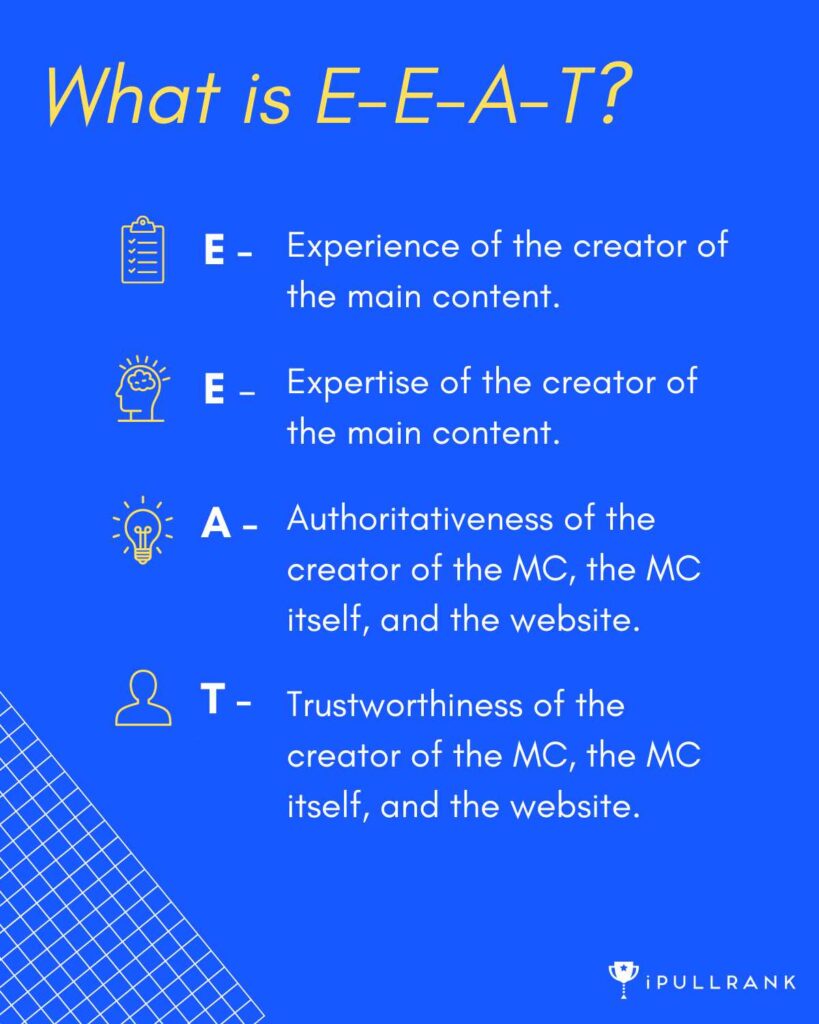
Google goes on to state that high E-E-A-T content exists in all industries and verticals and that the content should be factual, produced by experts and expert bodies, include perspectives from those that have experience, and be updated with accurate information regularly.
Again for the cheap seats in the back! Content should be factual, produced by experts and expert bodies, include experienced perspectives, and updated with accurate information regularly.
While Google is notorious for keeping the doors to the laboratory closed, this insider peek gives SEOs, content creators, and developers one of the clearest indicators of what high-quality content is. Can I get an Amen?!
With Google’s emphasis on serving high quality, it makes sense then that the August and March updates would work to diminish low quality and push high quality to the top.
WHY WERE SO MANY YMYL SITES HIT?
In an era of fake news, expertise, authority, and trustworthiness are more than “very important” quality factors. They are crucial to the business of information. It is in Google’s best interest to provide its users with the most factual information. Sure gossip sites can get away with making stuff up (and even they need to break celebrity news fast), sites under YMYL (health, financial advice, and lifestyle) need to be accurate.
Google writes:
“We have very high Page Quality rating standards for YMYL pages because low-quality YMYL pages could potentially negatively impact users’ happiness, health, financial stability, or safety.”
Google Search Quality Guidelines
YMYL sites are outlined as:
- Shopping/Financial Transaction pages
- Financial Information pages
- Medical Information pages
- Legal Information pages
- News pages/Public and Official Information pages
- Other: childcare, car safety, etc (use your judgment)
Looking at some of the top losers in the Moz post, there was a high presence of information-based websites in YMYL. While many of these sites may have seen improvements with the March 2019 update, there is still something to gain from all of the fluctuations.
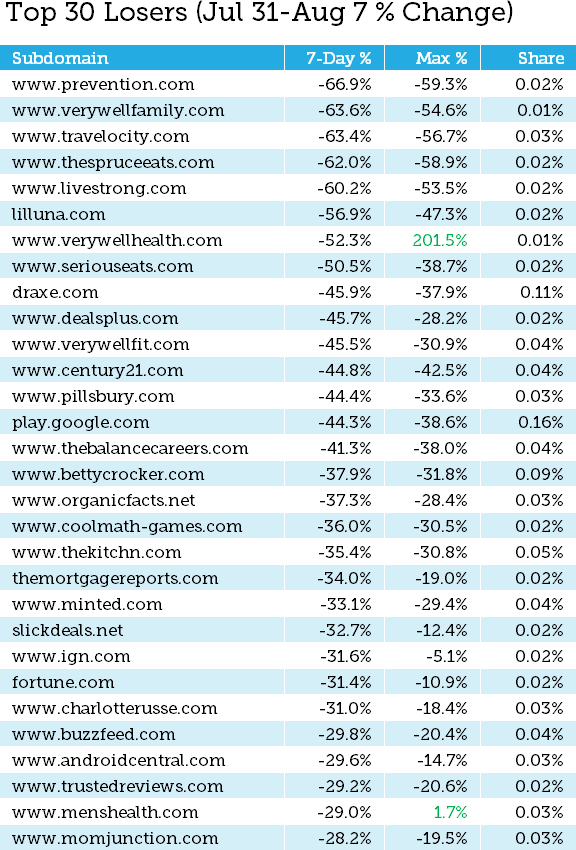
Because YMYL sites are providing direct advice that consumers will use and apply, they have to be diligent in ensuring that the content is factual, from an authoritative source, and can be trusted. The E-E-A-T for these sites is high and needs to be considered in all strategic content endeavors.
SO, WHAT DOES E-E-A-T LOOK LIKE IN YMYL?
Looking at the top losers (and these sites may very well have recouped their loss in March) publishing/media sites like VeryWellFamily, LiveStrong, and TheMortgageReport stand out. These sites are in the business of providing resourceful content that may “impact the future happiness, health, financial stability, or safety of users.”
While we can not pinpoint the exact pieces of content that caused Google to depreciate these sites, we can look at the overall content landscape from a high level to see how E-E-A-T has been deployed in the past.
MEDICAL: VeryWellFamily.com
It’s easy to understand why family planning and pregnancy websites are under heavier scrutiny by Google. The information that VeryWellFamily provides is medical in nature and needs to have the qualification of professionals in order for expecting women and families to take it seriously.
With that said, Verywellfamily.com did indeed suffer a sharp loss in the August 2018 update. It appears they recovered, yet took another small hit in March 2019.

Looking closer at a few of their biggest keyword losses, it appears that VeryWellFamily has revised their content strategy to incorporate E-E-A-T signals. Looking at the page that ranks for “pregnancy calculator” which dropped 4 positions, we can see how the article has changed from Dec 2018, shortly after the August update and in March 2019.
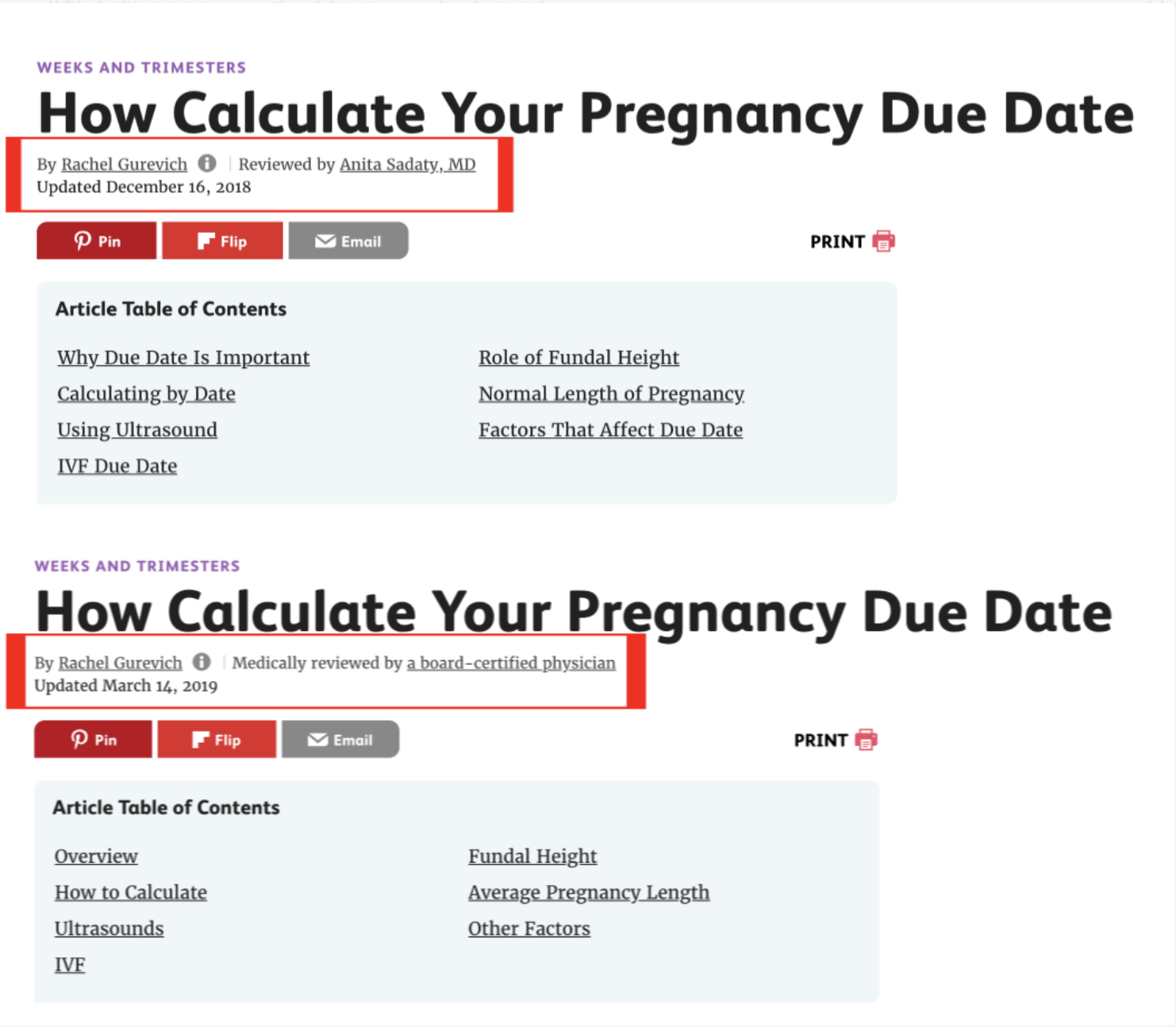
The VeryWell team was quick and astute in qualifying their content with a “Reviewed by” tag in December and a “Medically Reviewed” tag in March. This kind of seal of expertise will go a long way in qualifying their content not just for Google but for readers as well. When medically sensitive content is reviewed by an expert it engenders trust and helps to build authority.
LIFESTYLE: LiveStrong.com
Similar to pregnancy and family planning, nutrition and fitness advice is all over the web. While there are several governing boards for nutritionists and personal trainers (many that are not easily recognizable by consumers) sometimes having a wealth of content can undermine a website’s authority.
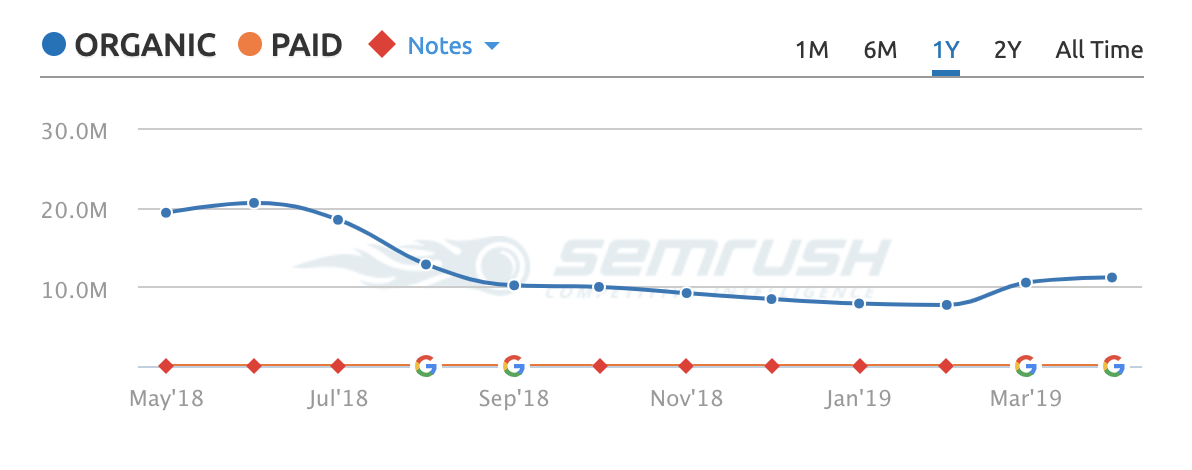
Livestrong.com was one of the larger sites hit by the August update and from the SEMRush overview, it appears that they have yet to fully recover but did see a spike in March 2019. In an ultra-competitive space it can be difficult to take the foot off the proverbial gas, but repositioning a bulk of content may be a worthwhile solution.
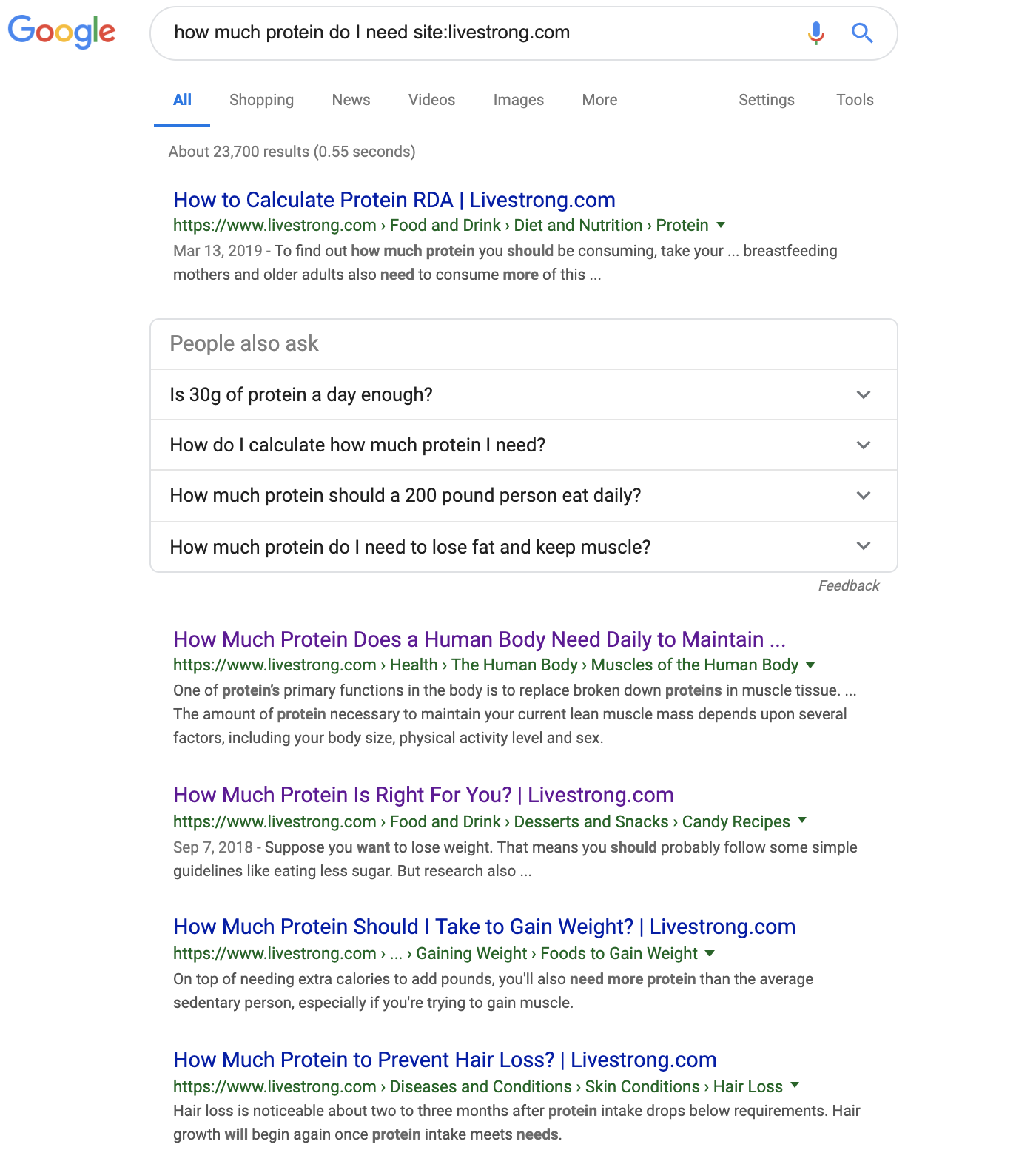
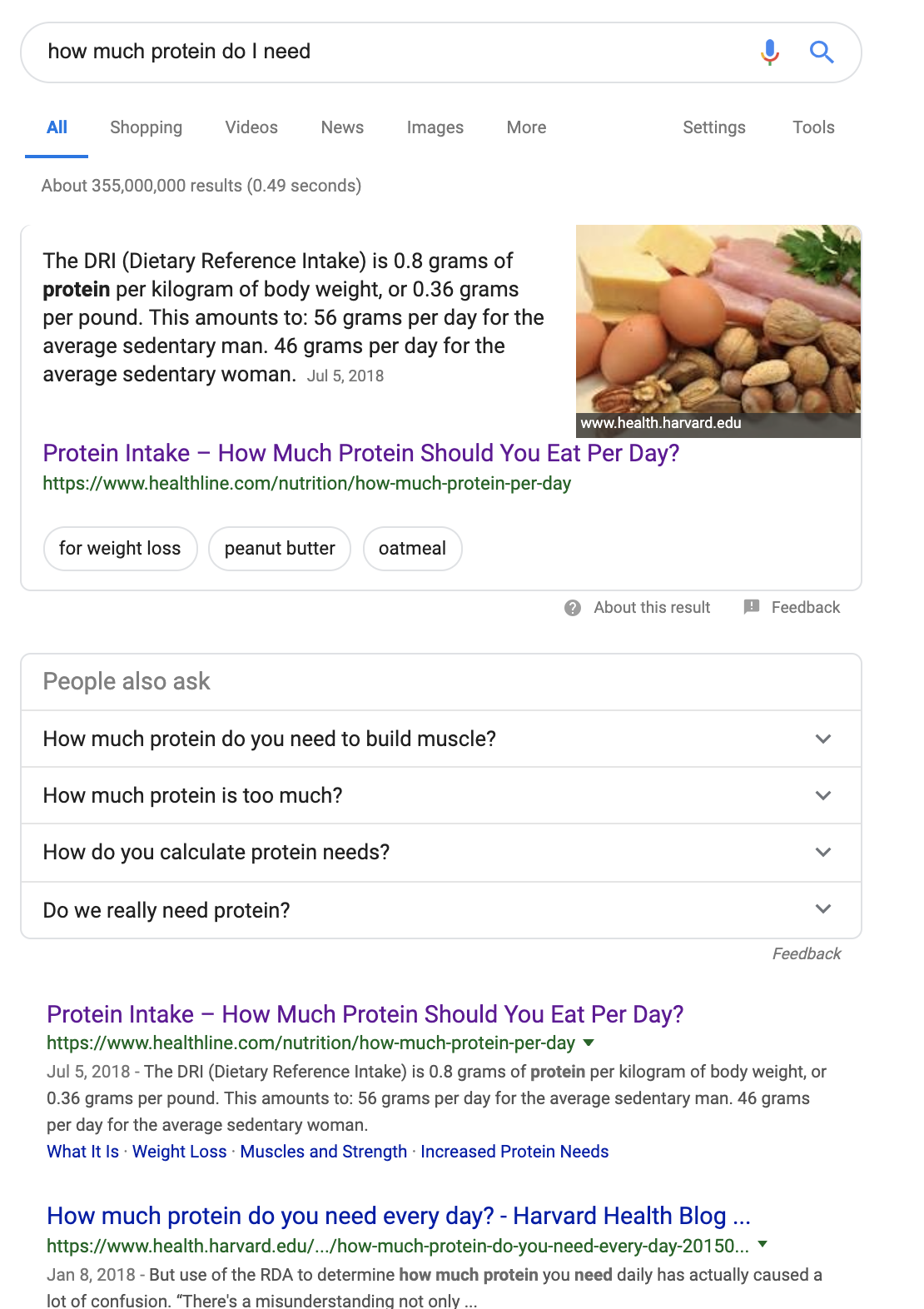
A search on “how much protein do I need” resulted in 23,700 listings on Livestrong.com. While the majority of these articles make similar recommendations, the sheer volume could be detrimental for Google in determining how authoritative and trustworthy each of these pages is. Additionally, an unmodified search on the same phrase returned results from:
- Healthline.com: Only 9,720 results
- Health.Harvard.edu: Only 2,340 results
In this instance, the sheer volume of information on Livestrong.com for this one key phrase may be competing for most authoritative which is causing Google to see none of it as such.
FINANCE: TheMortgageReports.com
Financial institutions and advice are heavily regulated and rightfully so. To protect the public, banking, and lending organizations must adhere to governmental regulations. One could look at Google’s E-E-A-T stance as a protection. One that financial companies can readily work well within.

In the case of TheMortgageReports.com, they saw a decrease in August but were able to quickly recoup and even saw further improvement in the March 2019 update. At the same time, based on the SemRush data, it appears that their paid traffic increased as well.
From a strategic standpoint, TheMortgageReports offset a lull in organic traffic with a revised and successful paid strategy.
But the efforts to shift monetization to paid advertising also benefited them content-wise. Looking at an old page from November 2017, the site at one point had a heavy dependence on sidebar advertising modules which was weighing down the trust of the site.

While Google has stated that the appearance of ads will not automatically deem a page low quality, they have said:
“Webmasters can choose to display Ads on their page (such as by joining an advertising network), but they may not always directly control the content of the Ads. However, we will consider a website responsible for the overall quality of the Ads displayed.”
Google Search Quality Guidelines
The current website content is ad-free. In the case of The Mortgage Reports, a shift from on-page monetization efforts to straightforward content and paid search has proven to help maintain their organic traffic and grow their paid visibility.
How to Incorporate E-E-A-T into your Content Strategy
While there are currently no hard metrics or ways to quantify E-E-A-T, the idea is still directional and in the case of the three examples above, we can determine methods to improve a site’s overall E-E-A-T. In understanding what expertise, authority and trustworthiness mean, content strategists can better devise a plan for content that meets those tenets.
Let’s look to Merriam-Webster for some definitions, ask some important questions about our content and look at recommendations for improving the E-E-A-T.
| Definition | Questions to Ask | Recommendations |
| Experience: 1: direct observation of or participation in events as a basis of knowledge 2: practical knowledge, skill, or practice derived from direct observation of or participation in events or in a particular activity | Is the main content from the POV of someone who has participated or experienced the topic? Can you prove through documentation, imagery, or video that the experience was first-hand? Do content contributors share their personal thoughts and knowledge on the subject? | Leverage people who are passionate and participate in the subject. They don’t have to be the definitive subject matter expert, they just need first hand experience. Demonstrate their experience with unique insights into the topic that only someone who has participated would have gone through. Add photos and videos taken by the experienced content creator. Social media can be a great channel to find experienced contributors. |
| Expertise: 1: the skill of an expert / 2: expert opinion or commentary | Is the main content from the POV of an expert? Is it the opinion or commentary of an expert? Is the information refutable? Will there be legal repercussions if a user takes this advice? Is your brand/company the expert to give this information? | Sourcing subject matter experts or soliciting the approval of a governing body is the best way to get ahead of this quality component. Some of the ways we source experts for our content creation include: Interview Internal SME: Based on the organization, there are subject matter experts with credentials that can provide feedback or information. Conducting interviews is a great way to get their expert advice without taking up much of their time. Don’t forget to put their qualifications on display. Help A Reporter Out Social Questions Sites such as Quora and StackExchange |
| Authority: power to influence or command thought, opinion, or behavior | Is your brand an authority in the space? Does this piece of content have the power to influence or command thought? How does this piece of content contribute to or undermine our authority? | Pagerank is still the standard to quantify a website’s authority (at least in the eyes of Google). While the toolbar is long gone, PageRank and link equity is still employed in the algorithm. And there are ways to determine your authority online and work to improve your authoritative presence. Improve Link Profile: Link equity is still, by and large, a great indicator of authority. Who links to you and how reputable (or not reputable) they are matters. Create Linkworthy Content: The greatest control you have is over your content and creating stellar stuff and creating a content distribution plan will facilitate the process but it begins with great content. |
| Trustworthiness: worthy of confidence: DEPENDABLE | Is our content consistent and reliable? Are we confident that this is the most authoritative piece on this subject? Can users trust the information presented here? | Are users saying good things about your content? Trust is what others say about you and when others are extolling and pointing to your work as exemplary it signals to the engines that the content is worthy of being ranked. Leverage Social Proof: While social signals may not impact rankings they do signal that a page is widely read and used and worthy of being trusted. Incorporate your content into your social media program. Think 10X: To be trusted is to be the best and when creating content, going above and beyond competitors will help you develop a reputation of quality. 10X content is 10 times better than what exists and when something is that good it breeds trust with readers. |
While these questions and recommendations are far from exhaustive, they present a starting point for brands to begin to evaluate their commitment to high-quality content.
If the rollbacks of August and March were any indication, Google has renewed its commitment to high-quality content and in the words of Danny Sullivan, the only “fix” is to produce high-quality stuff.
WHAT TO DO IF YOU ARE HIT BY A CORE UPDATE?
At iPR we deal with clients across multiple verticals including YMYL and have dealt with traffic depreciations and regaining organic visibility many times over. We take an always-on approach to managing visibility, as opposed to a reactive one, and when our clients face major losses we look to the site as a whole. Our process includes:
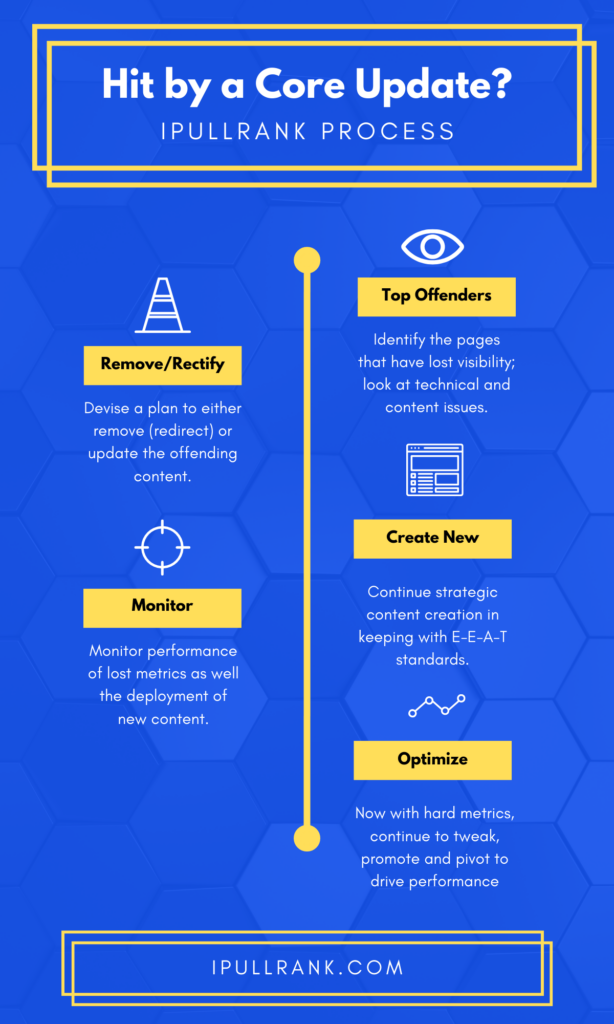
1. Identifying Top Offenders
Our first step in helping a site recover from a major loss is to analyze everything. While Google is speaking specifically to the purpose of content and its E-E-A-T, these issues may extend to the technical architecture, user experience, or link profile of a website. E-E-A-T principles are just as important for enterprise sites as well.
We audit every part to determine which is having the largest impact. Often times we find things that our clients were not aware of.
We recommend:
- Performing regular Site Audits to identify potential problems and get ahead of a core update
- Reviewing past Implementation Audits to identify any recent changes and how they may have made an impact
- Performing a Content Audit to get a full view of your content performance and identify which pages and site sections have taken the greatest hit
2. Rectify/Remove Issues
Once you have identified the pages and/or sections that have taken the biggest hit, it’s time to devise a strategy that will correct course but not handicap you in the long run. As Google has stated, a commitment to great content is the simplest way to deal with a core update.
We recommend:
- Reviewing the depreciated pages and revising them to be in line with E-E-A-T
- Working with experts to ensure content is fully vetted and launched top-notch
3. Create New Content
Once you have worked to rectify the offending pages, roll that process and insights into the creation and deployment of new content.
We recommend:
- Continuing a regular cadence of fresh content that meets Google’s Page Quality standards
- Developing internal workflows & processes to account for robust Quality Control
- Create external outreach for experienced contributors and subject matter experts
- Working with an agency like us that develops high-quality content and can facilitate this process
4. Monitor & Optimize
After a major hit like the August core update, you may be scrambling to regain what you lost. As we saw with the March update, sometimes the playing field levels as Google works through its changes. However, this is not always the case and you should be constantly monitoring traffic and pivoting based on performance.
We recommend:
- Revising your Measurement Plan to incorporate content metrics
- Developing an Optimization workflow to filter under-performing pages back into the optimization cycle
- Setting up custom dashboards and alerts for traffic and monitoring trends with other marketing efforts
- Reviewing other marketing channels to support the overall site health during a traffic depreciation
As Google continues its move toward a user-centric search, SEOs and brands can expect more incremental updates like the ones of August and March. While it is unsettling that these massive updates can wipe traffic it is also a clear indication from Google on what sites need to do to stay above board.
High-quality content has always been the answer, now we have a better definition of what that means. Let’s E-E-A-T.
NEXT STEPS
Here are 3 ways iPullRank can help you combine SEO and content to earn visibility for your business and drive revenue:
- Schedule a 30-Minute Strategy Session: Share your biggest SEO and content challenges so we can put together a custom discovery deck after looking through your digital presence. No one-size-fits-all solutions, only tailored advice to grow your business. Schedule your session now.
- Mitigate SGE’s Potential Impact: How prepared is your SEO strategy for Google’s Search Generative Experience? Get ahead of potential threats and ensure your site remains competitive with our comprehensive SGE Threat Report. Get your report.
- Enhance Your Content Relevancy with Orbitwise: Not sure if your content is mathematically relevant? Use Orbitwise to test and improve your content’s relevancy, ensuring it ranks for your targeted keywords. Test your content today.
Want more? Visit our Resources Page for access to past webinars, exclusive guides, and insightful blogs crafted by our team of experts. Everything you need to keep your business ahead of the curve is right at your fingertips.
Take the next step with iPullRank.

Need EXPERT HELP with an industry-leading SEO and CONTENT STRATEGY? CONTACT US!
Have you been hit by a core update? How are you working to create great content with E-E-A-T? Sound off in the comments below!







